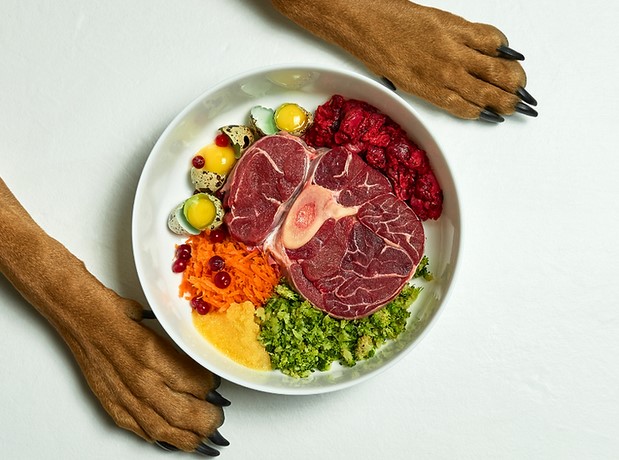
Knowing what to feed your pet is a confusing area to highlight, especially if you’re new to raising a pet. With the internet age, there’s so much information related to pet diets, ranging from allergies to raw food diets, in this article. So, what is a raw food diet? Is it something you should consider putting your pet on?
Over the last decade, feeding dogs and cats a raw food diet has become increasingly popular. Though there is some controversy related to it, it’s a typical conversation that comes up online and during a visit with the vet.
What is a Raw Food Diet for Dogs?
A raw food diet for dogs is when you feed your dog food that isn’t dog food and consists of raw foods (fruits, vegetables, organ meats, muscle meat, etc.). Some brands offer store-bought raw food for your dog, while others prepare it themselves with freeze-dried and dehydrated options.
The main attraction to the diet relates to how we eat today. More people are avoiding processed and refined foods in their daily diet, naturally attributing their diet choices to their pets. Furthermore, many argue that this diet type is the same as a wolf, and since dogs are related to wolves, they should eat the same food type. The same is said with cats since cats are related to lions and bobcats.
Advocates claim that the diet promotes shinier coats, healthier skin, better dental health, increased energy, and better weight management. Still, no matter the situation, careful care is required when handling and preparing the diet for your dog. A lot can go wrong if you’re not careful with what you’re feeding your dog. Remember to ask your vet before proceeding with any diet changes.
Examples of what Dogs Eat on a Raw Food Diet Include:
- Muscle Meat
- Bones (Whole or Ground)
- Organ Meats
- Raw Eggs
- Vegetables
- Apples or Other Fruit
Raw Food Diets for Cats
As mentioned, there are raw food diet options for cats, similar to dogs. Like the diet for dogs, a raw food diet for cats consists of raw foods and ignores processed or refined food options. Advocates believe the diet has higher protein and nutrient content than traditional cat food options.
Examples of what Cats Eat on a Raw Food Diet Include:
- Raw Muscle Meat
- Organ Meat
- Ground Bones
- Eggs
Why Don’t Some Vets Recommend Raw Diets? Why is it Controversial?
The unfortunate reality of a raw food diet for pets is that there isn’t any factual evidence to support any of the claims about the diet. No published studies on raw food diets prove or support the related theories. Furthermore, no studies prove that raw diets aid digestion, improve allergies, benefit dental health, or benefit coat health.
However, from the standpoint of domesticated pets being related to their wild counterparts, there is some truth. Yes, our pets are descendants of wild animals, but you must remember that our pets are much different now than they were thousands of years ago.
Nutritional Deficiencies
Thousands of years of breeding have drastically changed our pet’s look and behaviour. Most pets live in a heated house and are given food in a dish, meaning they’re far from their wild counterparts. On the contrary, wolves and lions hunt for their food and will eat whatever they come across.
Both dogs and cats have been thoroughly studied, meaning dogs are omnivores like humans, while cats are carnivores. It means that a modern dog requires carbs, fibre, protein, and fat to be healthy, while cats need protein, some carbs, and fibre.
Whereas raw diets don’t have the proper nutrients that cats and dogs require. Not getting the right vitamins and nutrients can cause issues in dogs and cats, including bad breath and more serious conditions such as liver damage, bone malformation, etc.
Safety and Hygiene
Besides the potential nutritional deficiencies and inaccuracies, safety and hygiene are significant concerns with the diet. Most people understand that eating raw meat is never a good idea since food requires thorough cooking to eliminate salmonella bacteria. The same is said with our pets.
Our pet’s digestive system can’t kill harmful bacteria, meaning they can become extremely ill from eating raw meat. Also, not only can our pets get sick from eating raw food, but they can also carry the bacteria themselves and make others sick, including us.
Raw Food Diet for Pets: Pros and Cons
Like anything else, a raw food diet could work for your pet if you’re careful and know the risks. Still, remember to talk with your vet before making this decision since the diet isn’t possible in all cases. As for now, if you don’t want to read the specifics of the diet and would rather have a pros and cons list, here you go:
Pros
- You know what’s in your pet’s food.
- It’s easy to customize.
- There could be benefits if done correctly.
Cons
- It’s expensive.
- There aren’t any studies supporting the diet.
- There’s a high risk of contagion.
- It’s easy to cause a nutritional imbalance.
- Preparing the food takes a long time.
- You need a lot of freezer space.
Popular Raw Food Diets For Dogs
Biologically Appropriate Raw Food (BARF) Diet:
The BARF diet, also known as the Canine Nourishment Blueprint, is designed to offer a balanced blend of essential nutrients for dogs. The recommended guidelines for a BARF diet include 70% muscle meat, 10% raw edible bone, 7% vegetables, 5% liver, 5% other-secreting organs, 2% seeds or nuts, and 1% fruit. This diet aims to maintain optimal health by closely replicating a dog’s natural diet in the wild.
Prey Model Raw (PMR) Diet:
The PMR diet is embraced by animal caretakers who incline toward their dog’s sustenance to emulate the inherent sustenance of a carnivorous being. It is a diet that follows the belief to eliminate processed foods to mimic the natural diet that their wild ancestors consumed. The endorsed guidelines are 75-80% sinewy flesh (chunked muscle meat), 10% uncooked palatable ossein (bone), 5% hepatic tissue, 5% additional excretory organs (i.e. liver), and 0-5% creature-based filament. These guidelines for a PMR diet are also for adult dogs and not puppies. Since each type of dog is different, it is best to consult with a vet for the best nutritional advice, especially if you are considering a PMR diet for your pet.
Does Raw Food Diet Increase Longevity?
Many raw food diet advocates point to a Belgian study that determined diet is one of the most significant factors affecting a dog’s lifespan. Many need to realize that the study determined a homemade diet had a better effect on longevity than industrially processed food.
Homemade doesn’t mean raw food diet, and as a result, there still aren’t any studies that show if a raw food diet increases longevity in pets. Although some may use a raw diet for their senior pets, that’s not recommended because of contagion and nutritional risks with the diet.
Conclusion
Regardless of your opinion, we all agree that the proper diet, exercise, and a caring environment will lead to the best outcome for your pet’s life. Regardless, remember to talk to your vet about what you’re thinking about diet-wise for your pet and if it’s worth considering. Feel free to drop in and discuss any diet plans with our staff at our Edmonton veterinary clinic.



